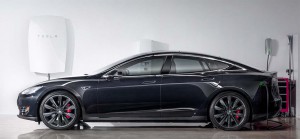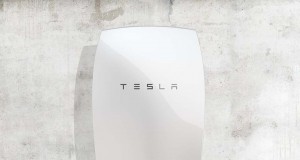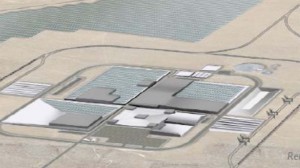Already providing a shock to the auto industry, entrepreneur Elon Musk is now hoping to transform the electric utility world. The billionaire founder of Tesla Motors added a new line of business Thursday night, confirming widespread rumors that the electric carmaker would add a line of residential and business battery backup systems.
In typical fashion, Musk declared the Powerwall system more than just the sort of technology that could keep a computer or TV running in the event of a power outage. Rather, he insisted during an evening news conference, that the system was another step in the goal of saving the environment by moving away from fossil fuels.
“This is within the power of humanity to do,” Musk proclaimed during a media briefing at Tesla’s design center in the Los Angeles suburb of Hawthorne. “We have done things like this before. It is not impossible.”
Set to go on sale later this year, the $3,500 Powerwall home system will provide up to 10 kilowatt-hours of backup energy using lithium-ion batteries. The system will provide a second outlet for the batteries that will be produced at the $5 billion Gigafactory Tesla is setting up near Reno, Nevada, helping balance demand in the event sales of the maker’s electric vehicles don’t reach expectations.
(Tesla CEO Musk making less than line workers – in salary, anyway. Click Here for more.)
The storage system will be marketed through a new division called Tesla Energy, and Musk said he expects it will be profitable almost immediately.
Indeed, Deutsche Bank has forecast stationary power could be worth $4.5 billion a year for Tesla, which has been operating in the red using traditional accounting methods. A separate report, issued by Morgan Stanley last year, suggested an energy storage system from Tesla could be “disruptive,” especially when paired with affordable solar energy technology, even encouraging some consumers to go “off-the-grid.”
Individual units, known as the Powerpack, not only could be used by homeowners looking for a backup system in the event of a blackout, but also serve as a way for solar energy users to cut the cord entirely, abandoning their local utilities. The primary problem with solar power, analysts note, is that it can’t provide power in the evening, when most homeowners need it the most.
(Musk nearly sold Tesla to Google. Click Here for the story.)
Tesla is looking at commercial applications, as well. Businesses also need backup power sources to prevent disruptions when the grid goes down. Telecomm companies already make extensive use of backup systems at their cellphone towers, for example. Companies also could use the technology to store power purchased during off-peak hours when it is cheaper.
Southern California Edison is already testing the use of Tesla batteries, while Amazon.com and Target also plan to make use of the commercial Powerwall system.
The underlying technology for Powerwall is “derivative” of what Tesla has already developed for its electric vehicles, Musk told reporters.
The market for battery back-up systems has been growing rapidly, though it has traditionally been centered around lead-acid batteries. In a forecast released earlier this year, TechNavio estimated so-called SLA, or stationary lead-acid, battery sales will increase at a compound annual rate of 6.9% through 2019.
While lithium-ion technology has a more difficult time handling extreme energy surges, it has a higher energy density, which means it can hold significantly more power in a smaller battery, making it easier for a homeowner to find a place for a Powerwall battery.
The $3,500 price tag for the Powerwall system is roughly in line with what a consumer currently pays for a modest-sized whole-house backup generator. The big difference is that the Tesla system can only store a fixed amount of energy – 10 kilowatt-hours in the basic version – while a generator can continue to provide power for days in the event of an ongoing emergency.
The average American household uses anywhere from around 18 kilowatt-hours to as much as 40 kWh daily, according to the U.S. Energy Information Administration. That means the Powerwall system would only offer limited backup, especially in a power outage lasting more than a matter of hours. By comparison, the Tesla Model S sedan can store as much as 85 kWh of electricity, enough to propel it for nearly 300 miles.
Though he sees a modest amount of demand, “I don’t believe this product in its first incarnation will be interesting to the average person,” Peter Rive, the chief technology officer at SolarCity told the Associated Press. Musk is chairman of that firm which is one of the country’s largest suppliers of residential solar power systems. Reve is his cousin and one of the firm’s co-founders.
SolarCity is one of several other companies planning to sell the new Powerwall.
(Click Here to find out where America’s greenest car shoppers live.)




The gullible will buy into the hype as usual just like with impractical EVs. As long as we have unscrupulous government such as Obama and the EPA promoting gasohol, mandating EVs and similar impractical schemes to dupe the public, consumers will pay for all of this technical ignorance.
Elon Musk is living proof that you can fool some of the people some of the time.
BTW there is nothing wrong with using fossil fuels for energy needs. Crude supplies in the ground regenerates themselves every 50-100 years and there is an abundance of it readily available to the world. We also have plenty of wind power and some solar power generation with more being installed weekly, so there is no need to stop using fossil fuels, contrary to the misinformation perpetuated by the tree huggers and misinformed.
This is industries changing.
But for the herd mentality corporation slaves types it will be similar to when the automobile first arrived and was reguired to have a person walk in front with a flag in front to not scare horses! I can see so many industries running scared. E